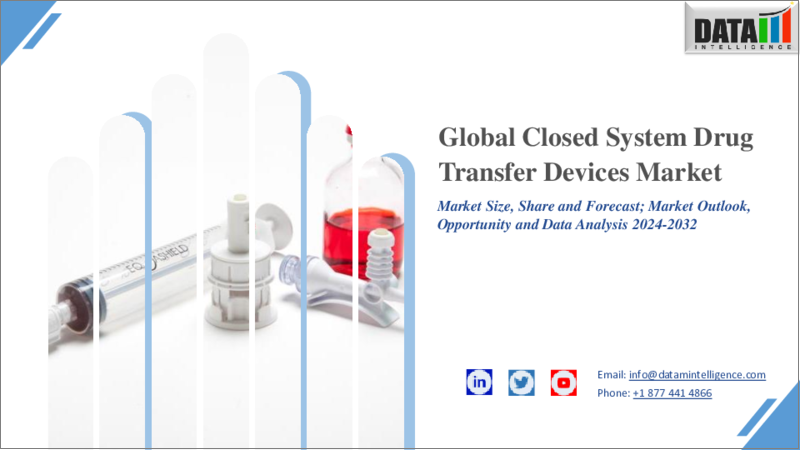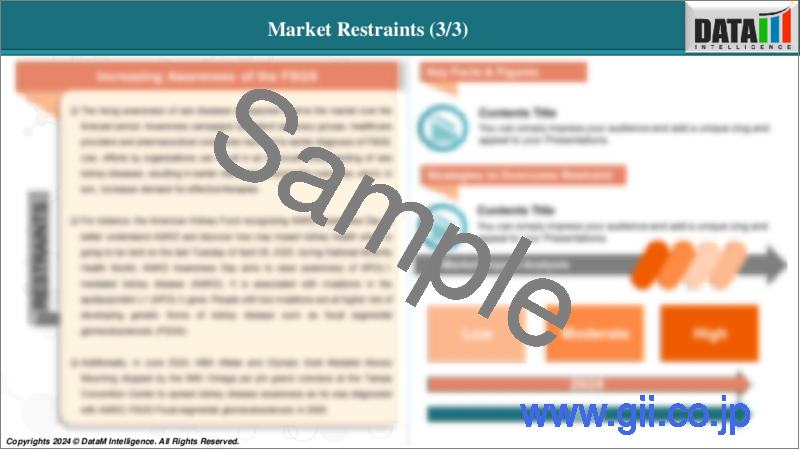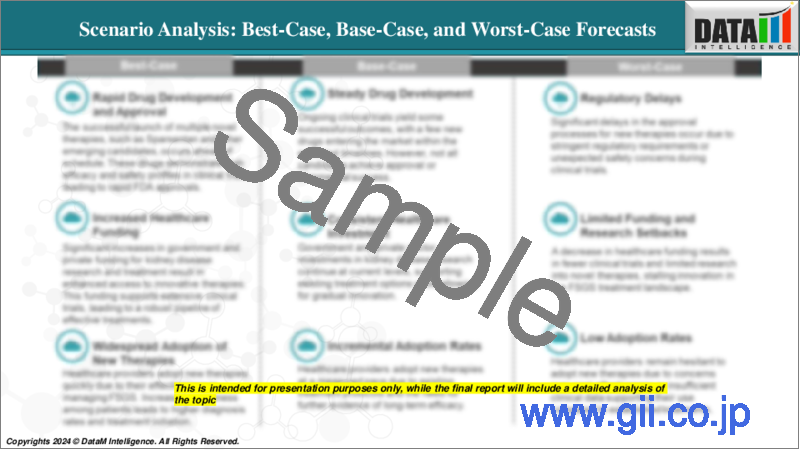|
|
市場調査レポート
商品コード
1560829
閉鎖式薬物移送デバイス(CSTD)の世界市場:2024年~2031年Global Closed System Drug Transfer Devices Market - 2024 - 2031 |
||||||
カスタマイズ可能
適宜更新あり
|
|||||||
| 閉鎖式薬物移送デバイス(CSTD)の世界市場:2024年~2031年 |
|
出版日: 2024年09月23日
発行: DataM Intelligence
ページ情報: 英文 184 Pages
納期: 即日から翌営業日
|
- 全表示
- 概要
- 目次
レポート概要
閉鎖式薬物移送デバイス(CSTD)の世界市場は、2023年に12億5,000万米ドルに達し、2031年には43億7,000万米ドルに達する見込みで、2024-2031年の予測期間中にCAGRで14.8%の成長が予測されています。
CSTDは、外部からの汚染物質のシステム内への侵入を防ぎ、システム外への危険な薬物物質や蒸気の放出を遮断することで、危険な薬物を安全に移送するために設計された特殊な医療機器です。
CSTDの主な目的は、危険物質への曝露リスクを大幅に低減する安全な環境を確立することです。このような危険な薬物への暴露は、医療従事者や患者にとって、皮膚の炎症、生殖に関する問題、さらにはがんなど、深刻な健康被害をもたらす可能性があります。CSTDは閉鎖的なシステムを構築することで、これらの強力な薬剤の取り扱いに関わるすべての人の健康を守る上で重要な役割を果たしています。
CSTDは一般に、物理的バリアCSTDと空気清浄CSTDという2つの設計コンセプトのいずれかに従っています。物理的バリアCSTDは、薬剤の蒸気、エアロゾル、液体が周囲の環境に漏出するのを機械的手段で阻止します。また、環境から無菌薬剤経路への汚染物質の取り込みも防止します。物理的バリアは、危険薬物と環境またはヘルスケアワーカーとの直接接触を防ぐ。これにより、薬剤を封じ込め、無菌状態を維持するための侵入不可能な境界が形成されます。
もうひとつは空気清浄です。CSTDは濾過技術を使用して、空気流から薬剤汚染物質を除去し、環境への放出を防ぎます。また、流入する空気をろ過し、環境汚染物質が無菌薬物経路に入る前に除去します。
物理的バリアCSTDも空気清浄CSTDも、薬物経路の無菌性を維持しながら、ヘルスケアワーカーと環境を危険な薬物への暴露から守るという同じ目標を達成するために設計されています。この2つのどちらを選択するかは、薬剤の特性、施設のレイアウト、使用者の好みなどの要因によって決まる。CSTDが適切に使用されれば、危険な薬剤の取り扱いに伴うリスクを大幅に軽減することができます。
市場力学:
促進要因
がん罹患率の上昇と技術の進歩
世界のCSTD市場の需要は、複数の要因によって牽引されています。主な要因の1つは、がんの有病率の上昇と技術の進歩です。世界的にがんの罹患率は急速に増加しており、化学療法やその他の危険な薬剤の需要につながっています。
CSTDの活用は、医療従事者を危険薬剤への職業的曝露から守るために不可欠です。これらの装置は、強力な薬剤、特に化学療法薬の取り扱いに関連するリスクを軽減するために特別に設計されており、医療従事者が意図せずに曝露した場合、深刻な健康被害をもたらす可能性があります。
WHOが2024年2月に発表したデータによると、2022年には世界で約2,000万人のがん患者が新たに報告され、約970万人が死亡しました。その年に最も多かったがんの種類は、肺がんで250万件(がん全体の12.4%)、乳がん230万件(11.6%)、大腸がん190万件(9.6%)でした。
がんによる死亡原因の第1位は肺がんで約180万人(18.7%)、第2位は大腸がんで90万人(9.3%)、第3位は肝臓がんで76万人(7.8%)でした。予測によると、2050年までにがん患者数は、主に人口増加により3,500万人に増加する可能性があります。その結果、がん患者の増加は、これらの強力な薬剤の安全な取り扱いを促進するCSTDの必要性を煽ることになります。
さらに、ニードルレスシステムの導入や閉鎖機構の強化など、CSTDの技術革新は、使いやすさと安全性を大幅に向上させ、医療現場での採用を促進しています。
また、業界の主要企業による技術の進歩、啓発プログラム、主な発展が市場開拓を後押ししています。例えば、2022年9月、Oxford Global主催のFormulation UK 2021イベントにおいて、サノフィの生物製剤医薬品開発チームリーダーであるHeloise Audat氏は、CSTDの評価に関するサノフィの方法について洞察に満ちた概要を発表しました。CSTDに関する最初の規制は2004年頃に導入され、ヘルスケアワーカーを危険薬物との組織的接触のリスクから保護することを意図していました。
同様に、BDが導入した「有害薬物表面汚染モニタリングプログラム」は、医療施設が現在の慣行を評価し、効果的な検査計画を策定し、有害薬物表面汚染の持続可能なモニタリングプログラムを実施できるように設計された包括的なエンドツーエンドのソリューションです。このプログラムは、調製・投与中の危険ドラッグへの潜在的曝露から医療従事者を保護することを目的としています。
また、2022年3月、世界の医療機器開発企業であるSimplivia Healthcare Ltd.は、新しいCSTDであるChemfortの近日発売を発表しました。この装置は、危険な薬剤の調製や投与に携わる医療従事者の安全性を高めるために特別に設計されています。
抑制要因
CSTDの導入コストの高さ、規制上の課題、個人の認識不足などの要因が市場の妨げになると予想されます。
市場セグメンテーション
世界のCSTD市場は、タイプ、コンポーネント、閉鎖機構、技術、エンドユーザー、地域によって区分されます。
ニードルレスシステムセグメントが世界のCSTD市場シェアの約74.3%を占める
予測期間中、ニードルレスシステムセグメントが最大の市場シェアを占めると予想されます。ニードルレスシステムは、危険な薬剤を扱うヘルスケアワーカーにとって重大な危険である針刺し損傷を防ぐために特別に設計されています。これらのシステムにより、従来の注射針が不要になるため、有害物質への偶発的な曝露リスクが低減されます。
さらに、業界の主要企業が革新的なデバイスを導入・発売することが、このセグメントの市場成長を後押ししています。例えば、ICU Medical, Inc.は、ケモロックの閉鎖式薬物移送デバイス(CSTD)を発表しました。CSTDは、機械的および微生物学的に閉鎖式で、針を使用しない設計で、調合および投与中に有害な薬剤の蒸気が漏れるのを防ぎ、薬剤の無菌性を維持します。
同様に、ユーコン・メディカルは、Arisure閉鎖式薬物移送デバイス(CSTD)を、化学療法やその他の危険な薬剤の調合、輸送、投与時に、医療従事者を危険な薬剤蒸気への暴露から保護するために設計されたと発表しました。Arisure CSTDは、直感的で使いやすい無針ルアーロック接続システムを採用しています。これにより、従来の針を使用するシステムと比較して、針刺し損傷のリスクがなくなります。ルアーロック接続は、バイアル、シリンジ、輸液バッグを接続する際に、安全で気密性の高いシールを形成します。
また、2023年11月、BD(ベクトン・ディッキンソン・アンド・カンパニー)は、患者ケアを強化し、同社のビジョンである"One-Stick Hospital Stay "をサポートするために設計された、PIVO Proと呼ばれる針を使わない新しい採血技術を発売しました。この革新的な装置は、米国食品医薬品局(FDA)から510(k)認可を受けており、Nexiva Closed IV Catheter System with NearPort IV Accessを含む、一体型および長尺の末梢静脈カテーテルとの互換性を提供する初めての製品です。
地域別市場分析
CSTDの世界市場シェアは北米が約45.2%を占める
北米におけるがん患者数の増加がCSTD市場の重要な促進要因となっているため、北米地域が予測期間中最大の市場シェアを占めると予想されます。化学療法やその他の危険な薬物治療を必要とする患者の増加に伴い、CSTDのような安全な取り扱いソリューションに対する需要が高まっています。
米国がん協会によると、2022年には米国で新たに約190万人のがん患者が診断され、約60万9,360人ががん関連で死亡すると推定されています。がんの負担が大きいことから、CSDT市場の需要が高まっています。
この地域では、多くの主要企業が存在し、技術の進歩、製品の上市と承認、高度な医療インフラ、がん治療薬の承認の増加がこの市場の成長を牽引しています。
目次
第1章 調査手法と調査範囲
第2章 定義と概要
第3章 エグゼクティブサマリー
第4章 市場力学
- 影響要因
- 促進要因
- がんの罹患率の上昇と技術の進歩
- 抑制要因
- CSTDの実施にかかるコストの高さ
- 機会
- 影響分析
- 促進要因
第5章 産業分析
- ポーターのファイブフォース分析
- サプライチェーン分析
- 価格分析
- 規制分析
第6章 タイプ別
- Membrane-to-Membraneシステム
- ニードルレスシステム
第7章 コンポーネント別
- バイアルアクセスデバイス
- シリンジセーフティデバイス
- バッグスパイク
- オス/メスルアーコンポーネント
第8章 閉鎖機構別
- Click-to-Lockシステム
- Luer-Lockシステム
- Push-to-Turn
- Color-to-Colorシステム
第9章 技術別
- ダイヤフラムベースデバイス
- 空気ろ過デバイス
第10章 エンドユーザー別
- 病院
- 腫瘍クリニック・センター
- その他
第11章 地域別
- 北米
- 米国
- カナダ
- メキシコ
- 欧州
- ドイツ
- 英国
- フランス
- スペイン
- イタリア
- その他欧州
- 南米
- ブラジル
- アルゼンチン
- その他南米
- アジア太平洋
- 中国
- インド
- 日本
- 韓国
- その他アジア太平洋地域
- 中東・アフリカ
第12章 競合情勢
- 競合シナリオ
- 市況/シェア分析
- M&A分析
第13章 企業プロファイル
- BD
- 会社概要
- 製品ポートフォリオと説明
- 財務概要
- 主な発展
- ICU Medical, Inc.
- EQUASHIELD
- B. Braun Medical Inc.
- Yukon Medical
- Simplivia
- West Pharmaceutical Services, Inc.
- Baxter International Inc.
- JMS Co.Ltd.
- Corning Incorporated
第14章 付録
Report Overview
The Global Closed System Drug Transfer Devices Market reached US$ 1.25 billion in 2023 and is expected to reach US$ 4.37 billion by 2031 growing with a CAGR of 14.8% during the forecast period 2024-2031.
A closed system drug transfer device (CSTD) is a specialized medical equipment designed to safely transfer hazardous drugs by preventing the introduction of external contaminants into the system and blocking the release of hazardous drug substances or vapors outside the system.
The primary purpose of CSTDs is to establish a secure environment that significantly reduces the risk of exposure to dangerous substances. Exposure to these hazardous drugs can have severe health consequences for healthcare professionals and patients, including skin irritation, reproductive issues, and even cancer. By creating a closed system, CSTDs play a crucial role in safeguarding the well-being of everyone involved in the handling of these potent medications.
CSTDs generally follow one of two design concepts: physical barrier CSTDs and air cleaning CSTDs. The physical barrier CSTD uses mechanical means to block the escape of drug vapors, aerosols, and liquids into the surrounding environment. They also prevent the intake of contaminants from the environment into the sterile drug pathway. The physical barrier prevents direct contact between the hazardous drug and the environment or healthcare worker. It creates an impenetrable boundary to contain the drug and maintain sterility.
Another one is the air cleaning CSTDs use filtration technology to remove drug contaminants from the airflow, preventing their release into the environment. They also filter incoming air to remove environmental contaminants before they can enter the sterile drug pathway.
Both physical barrier and air-cleaning CSTDs are designed to achieve the same goal of protecting healthcare workers and the environment from exposure to hazardous drugs while preserving the sterility of the drug pathway. The choice between the two depends on factors like drug properties, facility layout, and user preference. When used properly, CSTDs significantly reduce the risks associated with handling hazardous medications.
Market Dynamics: Drivers
Rising prevalence of cancer and technological advancements
The demand for the global closed system drug transfer devices (CSDTs) market is driven by multiple factors. One of the primary factors is the rising prevalence of cancer and technological advancements. The global incidence of cancer is increasing rapidly, leading to a demand for chemotherapy and other hazardous medications.
Utilizing closed system drug transfer devices (CSTDs) is essential for protecting healthcare workers from occupational exposure to hazardous drugs. These devices are specifically engineered to reduce the risks linked to handling powerful medications, especially chemotherapy drugs, which can present serious health threats if healthcare personnel are unintentionally exposed.
As per WHO data in February 2024, in 2022, approximately 20 million new cancer cases were reported globally, resulting in nearly 9.7 million deaths. The most prevalent types of cancer that year included lung cancer, with 2.5 million cases (12.4% of all cancers), breast cancer at 2.3 million cases (11.6%), and colorectal cancer with 1.9 million cases (9.6%).
Lung cancer was the leading cause of cancer-related deaths, accounting for about 1.8 million fatalities (18.7%), followed by colorectal cancer with 900,000 deaths (9.3%) and liver cancer with 760,000 deaths (7.8%). Projections indicate that by 2050, the number of cancer cases could rise to 35 million, primarily due to population growth. Consequently, the rise in cancer cases demands the fueling of the need for closed system drug transfer devices (CSTDs) to facilitate the safe handling of these powerful drugs.
Moreover, innovations in closed system drug transfer device (CSTD) technology, such as the introduction of needle-free systems and enhanced sealing mechanisms, significantly improve usability and safety, thereby driving their adoption in healthcare settings.
In addition, key players in the industry's technological advancements, awareness programs, and key developments are driving the market growth. For instance, in September 2022, during the Formulation UK 2021 event organized by Oxford Global, Heloise Audat, Drug Product Team Leader for Biologics Drug Product Development at Sanofi, presented an insightful overview of Sanofi's methods for evaluating closed system drug transfer devices (CSTDs). The first regulations on CSTDs came around 2004, intending to protect healthcare workers from the risk of systematic contact with hazardous drugs.
Similarly, BD introduced the Hazardous Drug Surface Contamination Monitoring Program is a comprehensive end-to-end solution designed to help healthcare facilities assess their current practices, develop an effective testing plan, and implement a sustainable monitoring program for hazardous drug surface contamination. This program aims to protect healthcare workers from potential exposure to hazardous drugs during preparation and administration.
Also, in March 2022, Simplivia Healthcare Ltd., a prominent global developer of medical devices, announced the upcoming release of Chemfort, a new closed system transfer device (CSTD). This device is designed specifically to enhance safety for healthcare professionals involved in the preparation and administration of hazardous drugs.
Restraints
Factors such as the high cost of implementation of CSTDs, regulatory challenges, and lack of awareness among individuals, are expected to hamper the market.
Market Segment Analysis
The global closed system drug transfer devices (CSDTs) market is segmented based on type, component, closing mechanism, technology, end-user, and region.
The needleless system segment accounted for approximately 74.3% of the global closed system drug transfer devices (CSDTs) market share
The needleless system segment is expected to hold the largest market share over the forecast period. Needleless systems are specifically designed to prevent needle stick injuries, a significant hazard for healthcare workers who handle hazardous drugs. These systems eliminate the need for traditional needles, thereby reducing the risk of accidental exposure to toxic substances.
Moreover, key players in the industry introducing innovative devices & launches help to drive this segment's growth in the market. For instance, ICU Medical, Inc. introduced the chemo-lock closed system transfer device (CSTD) utilizes a mechanically and microbiologically closed, needle-free design to prevent the escape of hazardous drug vapors and maintain the sterility of the drug during compounding and administration.
Similarly, Yukon Medical introduced the Arisure closed system transfer device (CSTD) is designed to protect healthcare workers from exposure to hazardous drug vapors during the compounding, transportation, and administration of chemotherapy and other hazardous medications. The Arisure CSTD utilizes a needle-free, luer lock connection system that is intuitive and easy to use. This eliminates the risk of needlestick injuries compared to traditional needle-based systems. The luer lock connections form a secure, airtight seal when connecting vials, syringes, and IV bags.
Also, in November 2023, BD (Becton, Dickinson and Company) launched a new needle-free blood draw technology called the PIVO Pro, designed to enhance patient care and support the company's vision of a "One-Stick Hospital Stay." This innovative device has received 510(k) clearance from the U.S. Food and Drug Administration (FDA) and is the first to offer compatibility with integrated and long peripheral IV catheters, including the Nexiva Closed IV Catheter System with NearPort IV Access.
Market Geographical Analysis
North America accounted for approximately 45.2% of the global closed system drug transfer devices (CSDTs) market share
North America region is expected to hold the largest market share over the forecast period owing to the increasing number of cancer cases in North America is a significant driver for the closed system drug transfer devices (CSTDs) market. As more patients require chemotherapy and other hazardous drug treatments, the a demand for safe handling solutions like CSTDs.
As per the American Cancer Society, in 2022, it was estimated that there would be approximately 1.9 million new cancer cases diagnosed and around 609,360 cancer-related deaths in the United States. The significant burden of cancer demand for closed system drug transfer devices (CSDTs) market.
In this region, a major number of key player's presence, technological advancements, product launches & approvals, well-advanced healthcare infrastructure, and growing oncology drug approvals are driving this market growth.
For instance, in September 2023, EQUASHIELD, a leading provider of closed system transfer devices (CSTDs) and automated pharmacy compounding solutions, has been recognized as the most used device for hazardous drug preparation and administration for five consecutive years by Pharmacy Purchasing & Products magazine. This remarkable achievement underscores EQUASHIELD's dedication to enhancing safety and efficiency in healthcare settings.
Similarly, in December 2023, West Pharmaceutical Services, Inc. a global leader in innovative solutions for injectable drug administration systems, announced FDA 510(k) clearance and launch of its Vial2Bag Advanced 13mm admixture device.
Also, in December 2021, B. Braun Medical Inc. announced the launch of the OnGuard 2 Closed System Transfer Device (CSTD) in the United States, which represents an advancement over its predecessor, the original OnGuard model. This new device incorporates several enhancements aimed at improving usability and safety for healthcare professionals handling hazardous drugs.
Market Segmentation
By Type
Membrane-to-Membrane Systems
Needleless Systems
By Component
Vial Access Devices
Syringe Safety Devices
Bag Spikes
Male and Female Luer Components
By Closing Mechanism
Click-to-Lock Systems
Luer-Lock Systems
Push-to-Turn
Color-to-Color Systems
By Technology
Diaphragm-Based Devices
Air Filtration Devices
By End-User
Hospitals
Oncology Clinics and Centers
Others
By Region
North America
U.S.
Canada
Mexico
Europe
Germany
U.K.
France
Spain
Italy
Rest of Europe
South America
Brazil
Argentina
The rest of South America
Asia-Pacific
China
India
Japan
South Korea
Rest of Asia-Pacific
Middle East and Africa
Market Competitive Landscape
The major global players in the closed system drug transfer devices (CSDTs) market include BD, ICU Medical, Inc., EQUASHIELD, B. Braun Medical Inc., Yukon Medical, Simplivia, West Pharmaceutical Services, Inc., Baxter International Inc., JMS Co.Ltd., and Corning Incorporated among others.
Key Developments
In April 2023, EQUASHIELD, a leading provider of closed system transfer devices (CSTDs) for hazardous drugs, announced that its EQUASHIELD Syringe Unit has received FDA clearance for full-volume use. This means the system's closed Syringe Unit prevents intended and unintended syringe plunger detachment and can be used safely up to its maximal nominal volume when handling hazardous drugs.
Why Purchase the Report?
To visualize the global closed system drug transfer devices (CSDTs) market segmentation based on type, component, closing mechanism, technology, end-user, and region and understand key commercial assets and players.
Identify commercial opportunities by analyzing trends and co-development.
Excel data sheet with numerous data points of the closed system drug transfer devices (CSDTs) market with all segments.
PDF report consists of a comprehensive analysis after exhaustive qualitative interviews and an in-depth study.
Product mapping is available in excel consisting of key products of all the major players.
The global closed system drug transfer devices (CSDTs) market report would provide approximately 78 tables, 72 figures, and 184 pages.
Target Audience 2024
Manufacturers/ Buyers
Industry Investors/Investment Bankers
Research Professionals
Emerging Companies
Table of Contents
1. Methodology and Scope
- 1.1. Research Methodology
- 1.2. Research Objective and Scope of the Report
2. Definition and Overview
3. Executive Summary
- 3.1. Snippet by Type
- 3.2. Snippet by Component
- 3.3. Snippet by Closing Mechanism
- 3.4. Snippet by Technology
- 3.5. Snippet by End-User
- 3.6. Snippet by Region
4. Dynamics
- 4.1. Impacting Factors
- 4.1.1. Drivers
- 4.1.1.1. Rising Prevalence of Cancer and Technological Advancements
- 4.1.2. Restraints
- 4.1.2.1. The High Cost of Implementation of CSTDs
- 4.1.3. Opportunity
- 4.1.4. Impact Analysis
- 4.1.1. Drivers
5. Industry Analysis
- 5.1. Porter's Five Force Analysis
- 5.2. Supply Chain Analysis
- 5.3. Pricing Analysis
- 5.4. Regulatory Analysis
6. By Type
- 6.1. Introduction
- 6.1.1. Market Size Analysis and Y-o-Y Growth Analysis (%), By Type
- 6.1.2. Market Attractiveness Index, By Type
- 6.2. Membrane-to-Membrane Systems *
- 6.2.1. Introduction
- 6.2.2. Market Size Analysis and Y-o-Y Growth Analysis (%)
- 6.3. Needleless Systems
7. By Component
- 7.1. Introduction
- 7.1.1. Market Size Analysis and Y-o-Y Growth Analysis (%), By Component
- 7.1.2. Market Attractiveness Index, By Component
- 7.2. Vial Access Devices *
- 7.2.1. Introduction
- 7.2.2. Market Size Analysis and Y-o-Y Growth Analysis (%)
- 7.3. Syringe Safety Devices
- 7.4. Bag Spikes
- 7.5. Male and Female Luer Components
8. By Closing Mechanism
- 8.1. Introduction
- 8.1.1. Market Size Analysis and Y-o-Y Growth Analysis (%), By Closing Mechanism
- 8.1.2. Market Attractiveness Index, By Closing Mechanism
- 8.2. Click-to-Lock Systems*
- 8.2.1. Introduction
- 8.2.2. Market Size Analysis and Y-o-Y Growth Analysis (%)
- 8.3. Luer-Lock Systems
- 8.4. Push-to-Turn
- 8.5. Color-to-Color Systems
9. By Technology
- 9.1. Introduction
- 9.1.1. Market Size Analysis and Y-o-Y Growth Analysis (%), By Technology
- 9.1.2. Market Attractiveness Index, By Technology
- 9.2. Diaphragm-Based Devices *
- 9.2.1. Introduction
- 9.2.2. Market Size Analysis and Y-o-Y Growth Analysis (%)
- 9.3. Air Filtration Devices
10. By End-User
- 10.1. Introduction
- 10.1.1. Market Size Analysis and Y-o-Y Growth Analysis (%), By End-User
- 10.1.2. Market Attractiveness Index, By End-User
- 10.2. Hospitals *
- 10.2.1. Introduction
- 10.2.2. Market Size Analysis and Y-o-Y Growth Analysis (%)
- 10.3. Oncology Clinics and Centers
- 10.4. Others
11. By Region
- 11.1. Introduction
- 11.1.1. Market Size Analysis and Y-o-Y Growth Analysis (%), By Region
- 11.1.2. Market Attractiveness Index, By Region
- 11.2. North America
- 11.2.1. Introduction
- 11.2.2. Key Region-Specific Dynamics
- 11.2.3. Market Size Analysis and Y-o-Y Growth Analysis (%), By Type
- 11.2.4. Market Size Analysis and Y-o-Y Growth Analysis (%), By Component
- 11.2.5. Market Size Analysis and Y-o-Y Growth Analysis (%), By Closing Mechanism
- 11.2.6. Market Size Analysis and Y-o-Y Growth Analysis (%), By Technology
- 11.2.7. Market Size Analysis and Y-o-Y Growth Analysis (%), By End-User
- 11.2.8. Market Size Analysis and Y-o-Y Growth Analysis (%), By Country
- 11.2.8.1. U.S.
- 11.2.8.2. Canada
- 11.2.8.3. Mexico
- 11.3. Europe
- 11.3.1. Introduction
- 11.3.2. Key Region-Specific Dynamics
- 11.3.3. Market Size Analysis and Y-o-Y Growth Analysis (%), By Type
- 11.3.4. Market Size Analysis and Y-o-Y Growth Analysis (%), By Component
- 11.3.5. Market Size Analysis and Y-o-Y Growth Analysis (%), By Closing Mechanism
- 11.3.6. Market Size Analysis and Y-o-Y Growth Analysis (%), By Technology
- 11.3.7. Market Size Analysis and Y-o-Y Growth Analysis (%), By End-User
- 11.3.8. Market Size Analysis and Y-o-Y Growth Analysis (%), By Country
- 11.3.8.1. Germany
- 11.3.8.2. U.K.
- 11.3.8.3. France
- 11.3.8.4. Spain
- 11.3.8.5. Italy
- 11.3.8.6. Rest of Europe
- 11.4. South America
- 11.4.1. Introduction
- 11.4.2. Key Region-Specific Dynamics
- 11.4.3. Market Size Analysis and Y-o-Y Growth Analysis (%), By Type
- 11.4.4. Market Size Analysis and Y-o-Y Growth Analysis (%), By Component
- 11.4.5. Market Size Analysis and Y-o-Y Growth Analysis (%), By Closing Mechanism
- 11.4.6. Market Size Analysis and Y-o-Y Growth Analysis (%), By Technology
- 11.4.7. Market Size Analysis and Y-o-Y Growth Analysis (%), By End-User
- 11.4.8. Market Size Analysis and Y-o-Y Growth Analysis (%), By Country
- 11.4.8.1. Brazil
- 11.4.8.2. Argentina
- 11.4.8.3. Rest of South America
- 11.5. Asia-Pacific
- 11.5.1. Introduction
- 11.5.2. Key Region-Specific Dynamics
- 11.5.3. Market Size Analysis and Y-o-Y Growth Analysis (%), By Type
- 11.5.4. Market Size Analysis and Y-o-Y Growth Analysis (%), By Component
- 11.5.5. Market Size Analysis and Y-o-Y Growth Analysis (%), By Closing Mechanism
- 11.5.6. Market Size Analysis and Y-o-Y Growth Analysis (%), By Technology
- 11.5.7. Market Size Analysis and Y-o-Y Growth Analysis (%), By End-User
- 11.5.8. Market Size Analysis and Y-o-Y Growth Analysis (%), By Country
- 11.5.8.1. China
- 11.5.8.2. India
- 11.5.8.3. Japan
- 11.5.8.4. South Korea
- 11.5.8.5. Rest of Asia-Pacific
- 11.6. Middle East and Africa
- 11.6.1. Introduction
- 11.6.2. Key Region-Specific Dynamics
- 11.6.3. Market Size Analysis and Y-o-Y Growth Analysis (%), By Type
- 11.6.4. Market Size Analysis and Y-o-Y Growth Analysis (%), By Component
- 11.6.5. Market Size Analysis and Y-o-Y Growth Analysis (%), By Closing Mechanism
- 11.6.6. Market Size Analysis and Y-o-Y Growth Analysis (%), By Technology
- 11.6.7. Market Size Analysis and Y-o-Y Growth Analysis (%), By End-User
12. Competitive Landscape
- 12.1. Competitive Scenario
- 12.2. Market Positioning/Share Analysis
- 12.3. Mergers and Acquisitions Analysis
13. Company Profiles
- 13.1. BD *
- 13.1.1. Company Overview
- 13.1.2. Product Portfolio and Description
- 13.1.3. Financial Overview
- 13.1.4. Key Developments
- 13.2. ICU Medical, Inc.
- 13.3. EQUASHIELD
- 13.4. B. Braun Medical Inc.
- 13.5. Yukon Medical
- 13.6. Simplivia
- 13.7. West Pharmaceutical Services, Inc.
- 13.8. Baxter International Inc.
- 13.9. JMS Co.Ltd.
- 13.10. Corning Incorporated (*LIST NOT EXHAUSTIVE)
14. Appendix
- 14.1. About Us and Services
- 14.2. Contact Us






